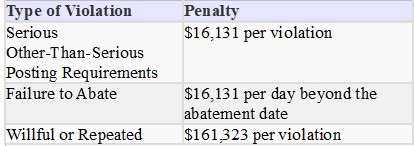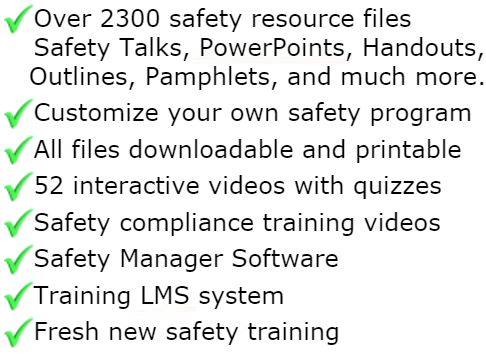
Ladder Safety Workplace Safety Program
Purpose
The purpose of this safety policy and procedure is to establish guidelines for the safe use of ladders throughout (COMPANY) by employees, contractors and visitors. Ladders are used when employees need to move up or down between two different levels. Slips, trips, and falls are significant contributors to COMPANY’s accidents. Slips, trips, and falls can occur when wrong ladder selection is made and when improper climbing techniques and/or defective ladders are used.
At COMPANY, the appropriate ladder will be used for the corresponding job and defective ladders will not be used. When hazards exist that cannot be eliminated, then engineering practices, administrative practices, safe work practices, Personal Protective Equipment (PPE), and proper training regarding ladders will be implemented. These measures will be implemented to minimize those hazards to ensure the safety of employees and the public.
Reference
This safety policy and procedure is established in accordance with Occupational Safety and Health Standards for General Industry (29 CFR 1910.25-27) and Occupational Safety and Health Standards for the Construction Industry (29 CFR 1926.1053).
Responsibilities
Managers/Unit Heads: Managers/Unit Heads are responsible for ensuring that adequate funds are available and budgeted for the purchase of ladders in their areas. Managers/Unit Heads will obtain and coordinate the required training for the affected employees. Managers/Unit Heads will also ensure compliance with this safety policy and procedure through their auditing process.
Supervisors
Supervisors are responsible for ensuring that all ladders (fixed and portable) are regularly inspected and properly maintained. They will also be responsible for tagging ladders in need of repair and removing defected ladders from service for repair or destruction. Supervisors will audit for compliance with this safety policy and procedure during their facility and jobsite audits.
Employees
Employees shall comply with all applicable guidelines contained in this safety policy and procedure. Employees are also responsible for reporting immediately suspected unsafe conditions or ladders to their supervisor. Employees are to inspect ladders before using and are to keep ladders clean and in good condition.
Safety and Loss Control
Safety and Loss Control will provide prompt assistance to managers/unit heads, supervisors or others as applicable on any matter concerning this safety policy and procedure. Additionally, Safety and Loss Control will assist in developing or securing of required training. Safety Engineers will provide consultative and audit assistance to ensure effective implementation of this safety policy and procedure. Safety and Loss Control will also work with Purchasing Department to ensure that all newly purchased ladders comply with this safety policy and procedure and current safety regulations.
Training
Ladder safety training shall be done upon initial employment and/or job assignment. Refresher training shall be provided to employees at the discretion of their supervisor. Employees using the ladders shall be trained in:
• The proper use of the ladders
• What kind of ladder to use
• How to set up ladders
• Ladder inspection
• Proper maintenance
Ladder Hazards & Safe Use
Ladder Hazards
There are inherent hazards associated with ladder use. Typical ladder hazards include:
• Insufficient surface resistance on ladder rungs and steps
• Ladder structural failure
• Ladders tipping sideways, backwards, or slipping out at the bottom
• Ladder spreaders not fully opened and locked, causing the ladder to “walk”, twist or close up when a load is applied to the ladder
• Using metal ladders around electricity
• Using deteriorated ladders
• Using fixed ladders without cages or fall protection
Safe Ladder Use
Employees should follow certain rules when placing, ascending, and descending ladders which include:
• Hold on with both hands when going up or down. If material must be handled, raise or lower it with a rope either before going down or after climbing to the desired level.
• Always face the ladder when ascending or descending.
• Never slide down a ladder.
• Be sure shoes are not greasy, muddy, or slippery before climbing.
• Do not climb higher than the third rung from the top on straight or extension ladder, or the second tread from the top on stepladders.
• Carry tools on a tool belt not in the hand.
• Never lean too far to the sides. Keep your belt buckle within the side rails.
• Use a 4 to 1 ratio when leaning a single or extension ladder. (place a 12 foot ladder so that the bottom is 3 feet away from the object the ladder is leaning against.)
• Inspect ladder for defects before using.
• Never use a defective ladder. Tag or mark it so that it will be repaired or destroyed.
• Never splice or lash a short ladder together.
• Never use makeshift ladders, such as cleats fastened across a single rail.
• Be sure that a stepladder is fully open and the metal spreader locked before starting to climb.
• Keep ladders clean and free from dirt and grease.
• Never use ladders during a strong wind except in an emergency and then only when they are securely fastened.
• Never leave placed ladders unattended.
• Never use ladders as guys, braces, or skids, or for any other purpose other than their intended purposes.
• Never attempt to adjust a ladder while a user is standing on the ladder.
• Never jump from a ladder. Always dismount from the bottom rung.
Ladder Safety Devices
Safety devices are available for both portable and fixed ladders to prevent a climber from falling. Safety devices for portable ladders include slip-resistant bases, safety tops, and any other device to increase the ladder stability. A portable ladder positioned at a location where it may be tipped over by work activities shall be securely fastened at the bottom and top. Safety devices for fixed ladders include cages (which enclose the stairwell) or a restraint belt attached to a sliding fixture anchored to the ladder.
Ladder Inspection
An inspection program should be set up by which all ladders are inspected once every three months. Appendix B presents a general inspection form. Ladders that are weak, improperly repaired, damaged, have missing rungs, or appear unsafe shall be removed from the job or site for repair or disposal. Before discarding a wood ladder, cut it up so no one can use it again. Additionally, portable ladders must be maintained in good condition at all times and inspected frequently. Tag any ladders that have developed defects with DANGEROUS--DO NOT USE, and remove from service for repair or disposal.
For portable wood ladders, all wood parts shall be free from sharp edges and splinters; sound and free from accepted visual inspection from shake, wane, compression failures, decay, or other irregularities. For portable metal ladders, the design shall be without structural defects or accident hazards such as sharp edges, burrs, etc. The selected metal shall be of sufficient strength to meet the test requirements and shall be protected against corrosion. For fixed ladders, all wood parts shall meet the criteria of wood ladders. All metal parts shall meet the criteria of metal ladders.
Maintenance
Portable wood ladders may be coated with a water-repellent preservative to provide a suitable protective material. Metal ladders and metal parts on wood ladders should be corrosion-resistant and kept free from nicks. If nicks occur, they

GET INSTANT ACCESS
to THE MEMBERS LIBRARY
Safety materials created by safety professionals.
Access to the Safety Manager software.
Wide variety of safety videos and courses.
**Brand New** Safety Training Management System
Pre-Made Safety Materials Ready For Use
Created by experienced safety professionals & risk consultants. Saving you time, money, and risk of injuries.
95% of the work already done.
Below are the maximum penalty amounts, with the annual adjustment for inflation, that may be assessed after Jan. 15, 2024. (See OSHA Memo, Jan. 8, 2024).

**New OSHA HEAT 90 DAY**
>>Download Free HERE<<
**New 2024 OSHA 300 Form**
>>Download Free HERE<<
**Brand New**
Free with full membership subscription
Training LMS System
Ask The Safety Consultant
Safety Equipment Deal Finder

“SafetyInfo.com is the first go-to website for safety professionals and companies to use in establishing a solid safety program"
-Mike McKenzie, Certified Safety & Health Manager (CSHM), McSafety Solutions™
Note: You must have a full subscription to the Safety Library in order to use this material. Any use outside of your organization, for resell, or without an active membership is strictly prohibited and may result in prosecution under copyright infringement laws. Please contact us first, if you would be interested in reselling or using our materials for reproduction.
Inside the Members Library
Topic Index
Accident Prevention
Air Quality
Asbestos
Bloodborne Pathogens
Boilers
Chemical Safety
Compressed Gas
Confined Space
Construction
Construction Worksite
Cranes & Slings
Driver / Fleet Safety
Drug Free Workplace
Electrical
Emergency Management
Engineering Safety
Environmental
Equipment
Ergonomics
Fall Protection
Fire Safety & Prevention
First Aid
Flammable Materials
Forklifts
Hazard Communication
Hazardous Materials
Hearing Protection
Heat Stress
Hot Work
Housekeeping
Job Safety Analysis
Laboratory
Ladders
Lead
Lockout-Tagout
Machinery & Equipment
Material Handling
MSDS (SDS)
Medical & First Aid
Occupational Health
Office Safety
Off the Job Safety
Personal Protection
Process Safety
Record Keeping
Respiratory Protection
Silica Safety
Rules & Policies
Signs & Labels
Slips, Trips & Fall
Training
Terrorism Programs
Tool Safety
Vehicle & Driver
Violence Programs
Welding & Hot Work
Training Videos
Library Index
Training Materials
Videos/Courses
Talks
Articles
PowerPoint
Handouts
Training Overheads
Quizzes
Supervisor Briefs
Management Briefs
Safety Sessions
2 Minute OSHA Safety Talks
Pamphlets
First Aid Training
Supervisor Training
Hazardous Materials
Bomb Threat
Crossword Puzzles
Biological Agents
Forms & Documents
Forms
Checklists
Audit Guides
Inspections Guides
Signs & Labels
Environmental Audit Guides
Recordkeeping - OSHA 300
Sign & Label Maker
Safety Management Resources
Safety Manuals/Written Programs
Ergonomic Programs
Emergency Plans
Process Safety Management
Construction Safety
Occupational Health
Environmental
Topic Sheets
DOT Fleet-Driver
Hazardous Materials
Chemical Safety
Drug Free Workplace
Terrorism Programs
Development Guides
Safety Manager Software
Safety References & Graphics
Technical Safety Information
Posters
Topic & Fact Sheets
Development Information
Job Specific Safety Rules
Terrorism
Calculators
Safety Comic Strips
New Safety Training System
Schedule and train your employees with our materials. Add unlimited amount of employees. Record all progress and issue certificates. For group and individual training sessions.

